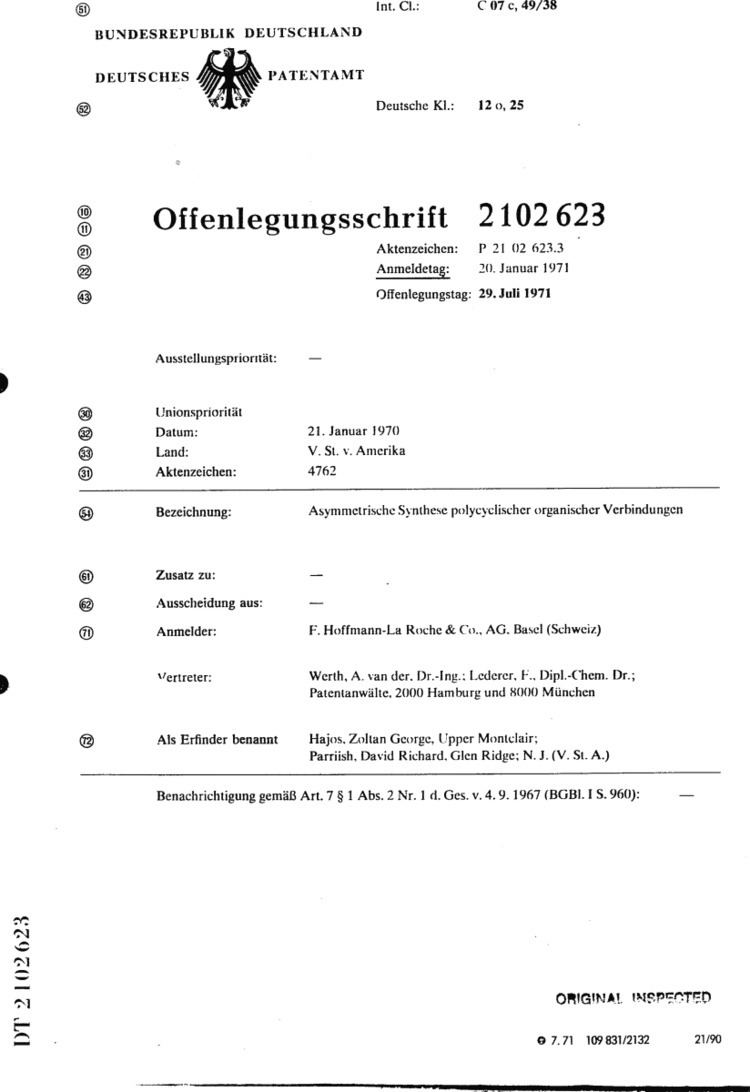Nationality Hungarian-American Academic advisor Zoltan Csuros | Name Zoltan Hajos Doctoral advisor Zoltan Csuros | |
 | ||
Institutions Hoffmann-La Roche, Johnson & Johnson Alma mater Technical University of Budapest Education Budapest University of Technology and Economics | ||
Zoltan George Hajos (born 3 March 1926) is a Hungarian-born and trained American organic chemist. Originally an academic in his native Budapest, then an industrial chemist in the pharmaceutical industry, he is known for the Hajos–Parrish–Eder–Sauer–Wiechert reaction (originally named Hajos-Parrish reaction by Claude Agami in 1985).
Contents
- Chemistry training
- Early academic career
- Second academic and pharmaceutical periods
- HajosParrishEderSauerWiechert reaction discovery and importance
- Awards and recognition
- Selected publications
- References
Chemistry training
Hajos studied chemistry at the Technical University of Budapest (TU Budapest), in Hungary, completing an M.Sc. in 1947, and his doctoral work under Zoltan Csuros of the Institute of Organic Chemical Technology in 1950.
Early academic career
Hajos remained there until accepting a position as assistant professor in organic chemistry at the TU Budapest in 1948, where he stayed until 1952, then as Lecturer at the University of Veszprem (1952-1953), returning as a Research Associate at the Institute of Organic Chemistry at TU Budapest in 1953. With backlash following the 1956 Revolution in October, 1956, Hajos left TU Budapest and communist Hungary for the United States, where he took a position as a research associate in organic chemistry, a senior postdoctoral-level position, in the Department of Chemistry at Princeton University, beginning in 1957.
Second academic and pharmaceutical periods
Hajos accepted a chemistry position with the Pharmaceutical Research Institute of Hoffmann-La Roche, a pharmaceutical company, in Nutley, New Jersey, in 1960. He remained in that position until beginning a second phase of an academic career in 1970, first in the Chemistry Department of the University of Vermont (1972-1973), and thereafter on the Faculty of Pharmacy of the University of Toronto (1973 -1974). Hajos returned to the pharmaceutical industry in 1975, proceeding through a series of positions at the Research Institute of Johnson & Johnson, until retiring in 1990.
Hajos–Parrish–Eder–Sauer–Wiechert reaction, discovery and importance
Hajos is noted for the Hajos–Parrish–Eder–Sauer–Wiechert reaction, and of the related (S)-proline-catalyzed synthesis route to the Hajos-Wiechert ketone, and is considered a pioneer in the research area of organocatalysis. In a recent review of the Hajos–Parrish–Eder–Sauer–Wiechert reaction as a name reaction, Daniel Zerong Wang describes it, and its synonyms, thus:
"This reaction was independently reported by two groups in 1971: the group of Hajos and Parrish [citing a German patent dated 29 July 1971] and the group of Eder, Sauer, and Wiechert [citing a German patent dated October 7, 1971, and a 1971 journal report in German and English translation]. It is an enantioselective [a]ldol [r]eaction catalyzed by (S)-proline… [and is] one of the earliest enantioselectively catalyzed reactions of practical use in synthetic organic chemistry. Owing to its wide application in organic synthesis, it has been extensively explored and extended to asymmetric [a]ldol... α-alkylation… Mannich... Michael [a]ddition... and α-amination… [reactions] of carbonyl compounds. In the literature, this reaction has been referred to by different names: [as the Hajos–Parrish–Eder–Sauer–Wiechert reaction]... Hajos-Eder-Sauer-Wiechert... Hajos-Wiechert... and Hajos-Parrish-Wiechert reactions."
Benjamin List, a leader in the modern field of organocatalysis, describes the importance of the discovery of the Hajos–Parrish–Eder–Sauer–Wiechert reaction thus:
"Discovered in the early 1970s, the Hajos–Parrish–Eder–Sauer–Wiechert reaction, a proline-catalyzed intramolecular aldol reaction [citing journal articles Hajos & Parrish (1974a) and Eder, Sauer & Wiechert (1971b)], represents not only the first asymmetric aldol reaction invented by chemists but also the first highly enantioselective organocatalytic transformation.
Awards and recognition
Hajos received a Certificate of Merit, an Iron Award, from TU Budapest in May 2013, in recognition of 65 years of professional service.
Selected publications
The research activity of Hajos resulted in 45 scientific publications in technical journals, as well as in more than 30 patents. Some selected publications are:
